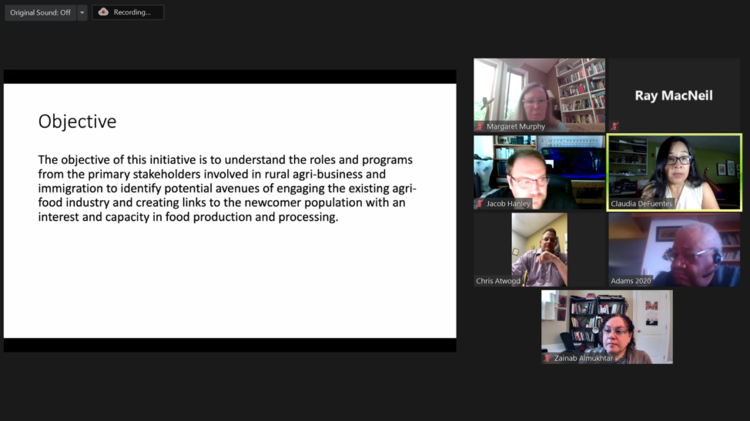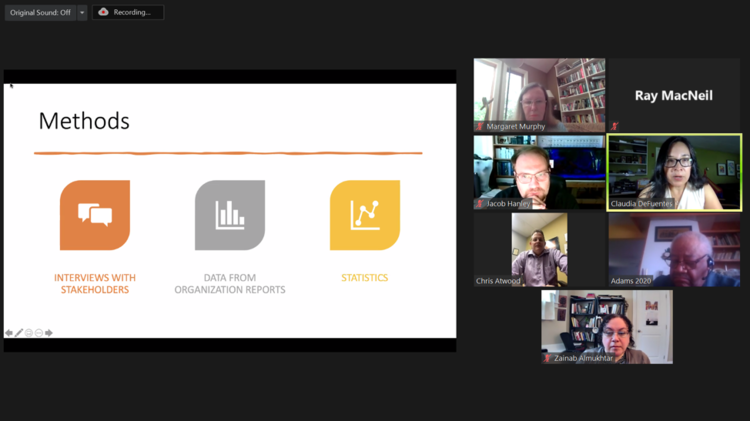Project co-lead Dr. Timothy Frasier (centre) with students.
Are clues to improved conservation of the critically endangered North Atlantic right whales lurking in their genes?
Genome Atlantic and Saint Mary’s University, Halifax, together with the New England Aquarium’s Anderson Cabot Center for Ocean Life, Boston, are teaming up on a $6 million, four-year study to find out. The Large-Scale Applied Research Project, funded by Genome Canada and managed by Genome Atlantic, is expected to get under way between July and September this year.
It is hoped the project’s findings will help conservation efforts become “more effective and efficient,” said Dr. Tim Frasier, one of the project’s two co-leads. A specialist in genetic analyses and marine mammal behaviour, he is an Associate Professor in the Department of Biology, Saint Mary’s University.
“Our work is focused on using genomic data to quantify the impact of inbreeding on reproductive success and species recovery, and to identify if there are long-term negative consequences of non-lethal entanglements in fishing gear,” he said. Genetic implications of non-deadly vessel strikes will also be investigated.
Given current failures to stop or reverse the right whale’s continuing decline, it is anticipated insights from the project could prove critical.
The North Atlantic right whale has been on endangered species’ lists in Canada and the United States for years. Yet today there are estimated to be less than 400 left, of which fewer than 100 are breeding females. In addition to having a high mortality rate from entanglement in fishing gear and vessel strikes, the species’ reproductive rate is also compromised. It is about three times lower than their known potential. A relatively high percentage of females have either never given birth or have had only one calf. Those females with multiple calves reproduce on average every six-to-10 years, as opposed to the expected three-year cycle.
With this low reproductive rate comes greater risk of the species’ extinction. Dr. Frasier’s project counterpart, Philip Hamilton, a leading expert on right whale biology and Senior Scientist at the Anderson Cabot Center for Ocean Life, New England Aquarium, wouldn’t hazard a guess at how long that scenario might take to play out on the current trajectory. However, he said, the North Atlantic right whale, though long-lived, could become “functionally extinct” sooner than later, “because reproductive females are killed at a faster rate.”
Project co-lead Philip Hamilton and his team of scientists from the New England Aquarium photograph a social group of North Atlantic right whales. (Photo: New England Aquarium, Brian Skerry)
“The important point, is that this species can survive and potentially thrive again, if we stop wounding and killing them with ropes and vessels,” he said. Encounters with fishing gear and vessels, coupled with declining reproduction rates, constitute a triple threat to North Atlantic right whale survival.
The genomic probe into these phenomena will benefit from complementary databases. Dr. Frasier’s lab maintains the archival tissue and DNA bank for the species, while Mr. Hamilton curates a photo database that contains all data on right whale health and reproduction.
Dr. Moira Brown, Senior Scientist at the Canadian Whale Institute, Welshpool, N.B., and a member of the project team, has noted big strides in molecular analysis of these mammals over her 40-year career. For her PhD thesis in 1988, she said, “I started the skin biopsy sampling program in the Bay of Fundy. Using a small stainless tip attached to a bolt launched from a crossbow, I sampled 25 whales that first year. The initial goal was to be able to identify males from females and to determine the sex ratio of the population using DNA analyses. Fast-forward three decades. Scientists have since learned a great deal about right whales from molecular analyses.”
Today, she said, 80 per cent of the whale population has been sampled, equipping researchers to address “the burning question: what, if any, is the impact of inbreeding on reproduction and how does that affect species recovery?” It is a question shipping and fishing industry representatives repeatedly ask her, and she hopes soon to have the answer.
The North Atlantic right whale research community is “extremely collaborative,” and has been so for decades, said Dr. Frasier. That factor made it easy, he said, to recruit researchers to this international project. He pointed out that the North Atlantic Right Whale Consortium – a data- and research-sharing group dedicated to the recovery of the species – has been active, since 1986, bringing together Canadian and American researchers, policy makers, fishing and shipping industry representatives and educators in an effort to conserve the species.
On another level, though, Mr. Hamilton pointed out right whales’ international movements between American and Canadian waters have complicated their plight. “Ideally,” he said, “right whales would be equally protected in both countries–a goal that is complicated by the two countries’ very different regulatory frameworks.”
Consequently, the research team is hoping to produce persuasive, actionable, scientific data for the Department of Fisheries and Oceans in Canada and the National Marine Fisheries Service in the U.S. to better manage North Atlantic right whale conservation in their respective jurisdictions. Researchers also hope their study’s findings can promote changes in fishing and shipping industry perceptions and behaviours to help the struggling right whale population rebound.
To ensure the project’s conclusions resonate in those circles, Dr. Randle Hart, a specialist in the sociology of science and, more particularly, in the way scientific information is chosen for incorporation in policy development, has been recruited to the research team from Saint Mary’s University.
Dr. Frasier described Dr. Hart’s role as “key to the success of this project.” He explained, “understanding how best to use the data available to result in the most effective and efficient conservation actions is a social science, and this is the work that Randy will be conducting.”
At the data-gathering end, the scientific team will measure the impact of inbreeding on reproduction and species recovery and attempt to fill a major knowledge gap on the role of genetic factors in wildlife conservation. Also, on the agenda are assessment of the long-term genetic impacts on whales that have had non-lethal encounters with vessels and fishing gear, and an evaluation of the team’s findings for North Atlantic right whale conservation.
Apart from the multi-million-dollar whale watching industry that has grown around them, whales play a vital role in stabilizing marine ecosystems by helping to regulate a wide spectrum of marine organisms with their presence. Their nitrogen-laden fecal matter, released when they rise to the ocean’s surface to defecate, for instance, is known to stimulate plankton growth and other microorganisms that form the foundation of the oceanic food chain, critical to the existence of marine life and for the maintenance of the fishing industry.
For seasoned right whale researchers, such as Mr. Hamilton, with more than 30 years in the field, these gigantic creatures remain endlessly fascinating.
Having studied these animals so long, he says he knows “almost every individual” and he has followed some of them “consistently year-to-year and habitat-to-habitat,” and yet, he said, so many questions are unanswered: “How do they locate their patches of prey? What do the loud, percussive ‘gunshot’ sounds they make signify? And how do they produce the sounds? Why do some whales make such long-range explorations, like Mogul, and how do they decide where to go?”
He added, “this species has been the underdog for most of my career. For the first two decades, the general public didn’t even know the species existed. People thought I was saying ‘white whale’ not ‘right whale.’ They had heard of belugas. Fighting for the underdog feels instinctive to me.
“Finally, every birth, every death, every injury has a face and a story behind it. Many of the whales alive today, I saw as calves. To watch them weather the many hardships of living in an urban ocean is heartbreaking. They can’t advocate for themselves. It’s up to those of us who know and care about them to speak for them.”
Others on the Frasier-Hamilton team besides Dr. Brown, all keenly committed to right whale welfare, include Dr. Angelia Vanderlaan, Research Scientist, Bedford Institute of Oceanography, Fisheries and Oceans Canada, Dartmouth, N.S.; Dr. Linda Rutledge, a bioinformatics expert and Assistant Professor in the Biology Department, Trent University, Peterborough, Ont.; Dr. Michael Asaro, Economist, NOAA (National Oceanic and Atmospheric Administration) Northeast Fisheries Science Center, Woods Hole, Mass; Dr. Robert Schick, Independent Research Scientist, Marine Geospatial Ecology Lab, Nicolas School of Environment, Duke University, Durham, S.C.; and R. Clay George, Senior Wildlife Biologist, Georgia Department of Natural Resources, Nongame Conservation Section, Brunswick, Ga.
Besides Genome Canada funding, the project is being supported by Fisheries and Oceans Canada and Research Nova Scotia in Canada, and by the Georgia Department of Natural Resources, the US National Marine Fisheries Service, and the New England Aquarium in the United States.
This article first appeared in on the Genome Atlantic website and has been republished with permission.















